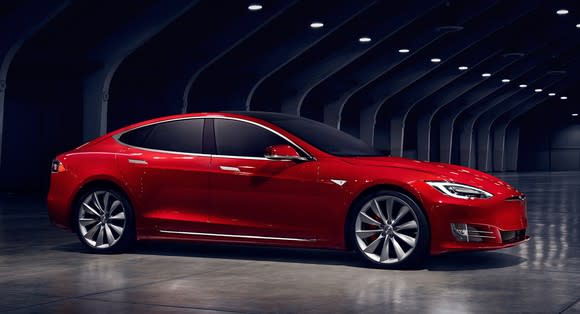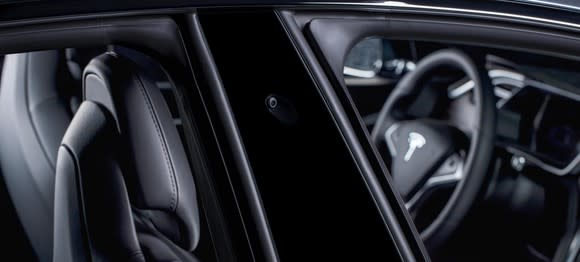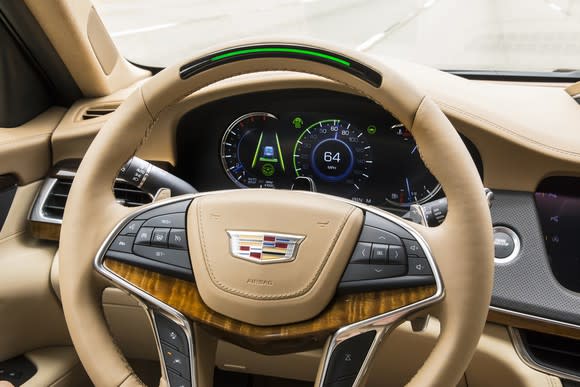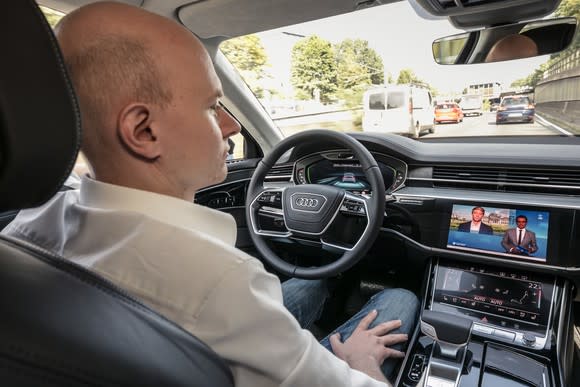Partial Automation: 2017’s Cars With Autopilot
Someday, we're told, self-driving cars won't need human drivers at all. We're not there yet, but there are a few cars available today with systems similar to an airliner's autopilot -- a system that can handle the driving for a while under certain circumstances, like stop-and-go highway traffic.
Here are three automakers that are currently offering some form of automotive autopilot system that can handle the driving for you at certain times. All of these systems can accelerate, brake, and steer the vehicle by themselves under limited circumstances, but all require a human driver who is alert and ready to take over the driving on short notice if it becomes necessary.

Tesla introduced the idea of an automotive "autopilot" on its Model S sedan. Now, a couple of other automakers offer similar systems. Image source: Tesla.
Tesla's Autopilot
Tesla's (NASDAQ: TSLA) done more than any other automaker to popularize the concept of an automotive autopilot -- it even calls its system "Autopilot" -- and its system has steadily gained more capabilities over time. Like others, Tesla's system uses cameras and radar to allow the car's computer to "see" the surroundings and keep the car on a safe path, along with software that Tesla has updated periodically over time with improvements and new features.

Tiny cameras and radar units built into Tesla's Model S help keep its Autopilot system informed. Image source: Tesla.
Current versions of Autopilot allow for hands-free driving on highways and in stop-and-go traffic, and can handle a few other situations, as well. Tesla has always been clear that the system is a "beta" -- a work in progress that will eventually evolve into a full-blown self-driving system. Those warnings got louder after a fatal accident in 2016, when a Tesla Model S running on Autopilot hit a tractor-trailer at full speed, killing its driver.
After that accident, Tesla updated Autopilot to require that the human driver touch the steering wheel every few minutes. The larger takeaway from that accident is this: As with the other systems on our list, the driver of an Autopilot-enabled Tesla needs to stay alert and ready to take over driving on short notice.
General Motors Super Cruise
If you haven't been following the rapid evolution of automotive technology over the last few years, it might seem strange to see General Motors (NYSE: GM) on this list. But today's GM is a technological powerhouse. Its self-driving subsidiary, Cruise Automation, said recently that it has completed development work on a full-blown Level 4 self-driving vehicle that can be mass-produced.
That's coming in the not-too-distant future. Right now, you can get GM's take on the highway-autopilot idea -- though it isn't cheap. It's a system called Super Cruise that just recently became available as an option on the big Cadillac CT6 sedan.
A cynic might say that the difference between Super Cruise and Autopilot is the difference between a big corporation with a big legal department and a fast-moving tech start-up. But GM might respond that the 2016 Tesla accident made it clear that partial self-driving systems needed to more carefully manage the transfer of control between the system and the human driver.

That green light in the steering wheel of a new Cadillac CT6 means that the Super Cruise system is activated and working. Image source: General Motors.
So what is it? Super Cruise is a system that allows for hands-free driving on divided highways with clear lane markings. Like Tesla's system, Super Cruise uses cameras and radar to help the car "see" its surroundings. But it also uses an additional camera, one that's pointed at the human driver to ensure that his or her eyes are on the road. If it senses your attention drifting, it'll work through an escalating series of alerts.
Those alerts center around a special light built into the steering wheel's rim. The light is green when Super Cruise is working, but it'll begin blinking -- and then turn red -- if the system thinks the human driver's attention is needed. As a last resort, the car will use a stern-sounding voice alert -- and if you still don't respond, it'll bring the car to a stop and use GM's OnStar system to call for help.
That may all sound excessively nannyish, but most reviewers agree that the clear warnings inspire confidence: You know the system won't do anything it can't safely handle. And unlike Autopilot, you won't be reminded to touch the steering wheel while the system is working.
Audi's Traffic Jam Pilot
German luxury-car maker Audi AG (NASDAQOTH: AUDVF), a subsidiary of giant Volkswagen AG (NASDAQOTH: VLKAY), is in the process of rolling out a partial self-driving system called "Traffic Jam Pilot" as an option on its all-new top-of-the-line A8 sedan.
Traffic Jam Pilot works a lot like Super Cruise, but as its name suggests, it's considerably more limited. It only works on a divided highway -- and only under 60 kilometers per hour (about 37 miles per hour). You can't use it in regular highway driving, only in traffic jams.

As its name suggests, Audi's new Traffic Jam Pilot allows for hands-free driving in stop and go highway traffic below 37 miles per hour. Image source: Audi AG.
Why the low speed limit? The idea behind Audi's system is that it handles stop-and-go highway traffic for you, keeping the car at a safe distance (but not too far behind) the vehicle in front. It's far from full self-driving, but if your daily commute regularly features traffic jams, you might find it relaxing to engage the system and steal a glance at the newspaper while the car navigates itself for a bit.
The upshot: These are more than just gimmicks
They might not sound all that impressive, but these systems are important technological steps along the path to those fully self-driving cars of the not-too-distant future. Not only do they offer some convenience for their users, they're also helping the automakers gather data to make those future systems safer and more reliable -- while giving the automakers' marketing departments some bragging points, in the meantime.
More From The Motley Fool
Why You're Smart to Buy Shopify Inc. (US) -- Despite Citron's Report
6 Years Later, 6 Charts That Show How Far Apple, Inc. Has Come Since Steve Jobs' Passing
NVIDIA Scores 2 Drone Wins -- Including the AI for an E-Commerce Giant's Delivery Drones
John Rosevear owns shares of General Motors. The Motley Fool owns shares of and recommends Tesla. The Motley Fool has a disclosure policy.

 Yahoo Finance
Yahoo Finance 